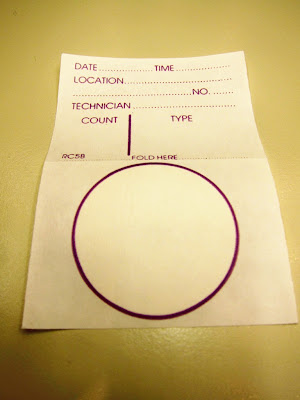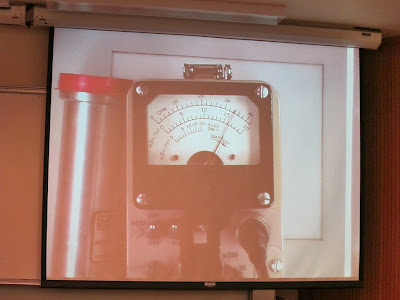The Technical Workshop entitled “On-Site Detection of Radioactive Contamination” was co-organized by Hong Kong Accreditation Service (HKAS), Hong Kong Council for Testing and Certification (HKCTC), and The Chinese University of Hong Kong (CUHK) on 21 & 22 June 2011.
Many people misunderstand that all radiation could be measured easily by using radiation detection meter. The background knowledge and technique were underestimated. After this workshop, we knew more in-depth on the detection of radioactive contamination and had a chance to use different type of radiation detector. Therefore, I would like to share some information I learnt from the workshop below.
In the beginning, Mr. WW Wong (Sr. Accreditation Officer, HKAS) gave an opening speech. The workshop aimed to enhance the knowledge on radioactive contamination detection because of increasing the test demand after the accident of Fukushima, Japan.

The first speaker was Mr. AU Sze Mun (Physicist, Radiation Health Unit, Department of Health) and his presentation title was “Practice and limitations of on-site detection of radioactive contamination”.

Firstly, Mr. AU introduced some basics on radioactivity to us. Antoine Henri Becquerel (15 December 1852 – 25 August 1908) was introduced. He is a French physicist, Nobel laureate, and the discoverer of radioactivity along with Marie Curie and Pierre Curie. They won the Nobel Prize in Physics in 1903.

The some common nuclides’ half-life were shown such as Tc-99m, Au-198, I-131, Co-60, etc. Moreover, the natural radiation exposure was mentioned.

The iodine-131 contamination characteristics were described. The information was from “Radionuclide and Radiation Protection Data Handbook 2002. (See reference)

Some agents for cleaning radioactive contamination were introduced.

Moreover, the transport package for radioactive source was also very important.

It could be referred to IAEA Safety Standards – Regulations for the Safe Transport of Radioactive Material – No. TS-R-1 (2009).

After that Mr. AU discussed many contamination cases to us such as Chernobyl in 1986, Goiania in 1986, Tokaimura – 1999, and Fukushima, Japan in 2011.

Since the accident in Japan was so serious on 11 March 2011, IAEA posted the draft standard entitled “Criteria for Use in Preparedness and Response for a Nuclear or Radiological Emergency – No. GSG-2” on 14 March 2011 on the website.

Then Hong Kong Daya Bay Contingency Plan was also posted for public. The Operational Intervention Levels (OILs) in Hong Kong was above 30 Bq/cm2.

The OILs used in Germany were briefed for reference.

Evaluation of surface contamination were found using ISO standard (ISO 7503-1, -2 & -3).

Different types of surface contamination monitor were shown and the square head one was commonly used in the Hong Kong government.

It should be care about the unit of the meter. HK government used Bq/ cm2 for standard mixture (with specific calibration factor).

The calibration of surface contamination monitors should follow ISO 8769.

Some reference sources were introduced such as C-14 (156keV), Pm-147 (225keV), Cl-36 (710keV), Sr-90+Y-90 (2274keV) and Am-241 (5544keV), where () is Max Energy in keV.

Eventhough the calibration and reference standard was available, the interlaboratory comparison results were up to about 40% deviation.

The Mr. AU discussed to measure the actual sample should be identified the source of contamination. It may be the package, content or both.

Some surface contamination needed to use wipes for removable contamination. It was an indirect measurement.

The wipes paper was demonstrated. Then the removal factor was discussed such as F=0.1 if it is not determined experimentally.

The following photos showed the conducting contamination survey.

The second speaker was Mr. Yip Sung Tat and his topic named “Detection and Measurement of Radiation by hand-held equipment.

His talk was more focused on safety such as dosage for non-radiation worker to be introduced.

He explained the different between dose rate meter and surface contamination monitor.

ABCD was introduced before use the monitor. They stand for Assess, Battery, Calibration and Detectable.

The photo showed the battery check.

The real detection reading was shown.

The label for radioactive source and its package were briefed.

China standard GB18871 was mentioned.

After that Mr. Yip demonstrated how to use different monitors and the sources.





I tried to use the special monitor (Gamma Dose Rate meter). It needed to use the body of the rod.

The workshop location was in Science Centre North Block, CUHK and it was also called Charles Kuen Kao Building.

I also saw Chen Ning Yang Reading Room. Both are Nobel Prize winner in Physics.
My previous related article:
Ionizing Radiation Safety - http://qualityalchemist.blogspot.com/2011/03/ionization-radiation-safety.html
Reference:
Radionuclide and Radiation Protection Data Handbook 2002 - http://www.nuc.berkeley.edu/files/Radionuclide_Data_Handbook%20final.pdf
IAEA Safety Standards – Regulations for the Safe Transport of Radioactive Material – No. TS-R-1 (2009) - http://www-pub.iaea.org/MTCD/publications/PDF/Pub1384_web.pdf
Criteria for Use in Preparedness and Response for a Nuclear or Radiological Emergency – No. GSG-2 - http://www-pub.iaea.org/MTCD/publications/PDF/Pub1467_web.pdf
ISO 7503-1:1988 - Evaluation of surface contamination - Part 1: Beta-emitters (maximum beta energy greater than 0,15 MeV) and alpha-emitters
ISO 7503-2:1988 - Evaluation of surface contamination -- Part 2: Tritium surface contamination
ISO 7503-3:1996 - Evaluation of surface contamination -- Part 3: Isomeric transition and electron capture emitters, low energy beta-emitters (E bêtamax less than 0,15 MeV)
ISO 8769:2010 Reference sources - Calibration of surface contamination monitors - Alpha-, beta- and photon emitters
ISO 8769-2:1996 Reference sources for the calibration of surface contamination monitors - Part 2: Electrons of energy less than 0,15 MeV and photons of energy less than 1,5 MeV
GB18871-2002 电离辐射防护与辐射源安全基本标准

沒有留言:
發佈留言